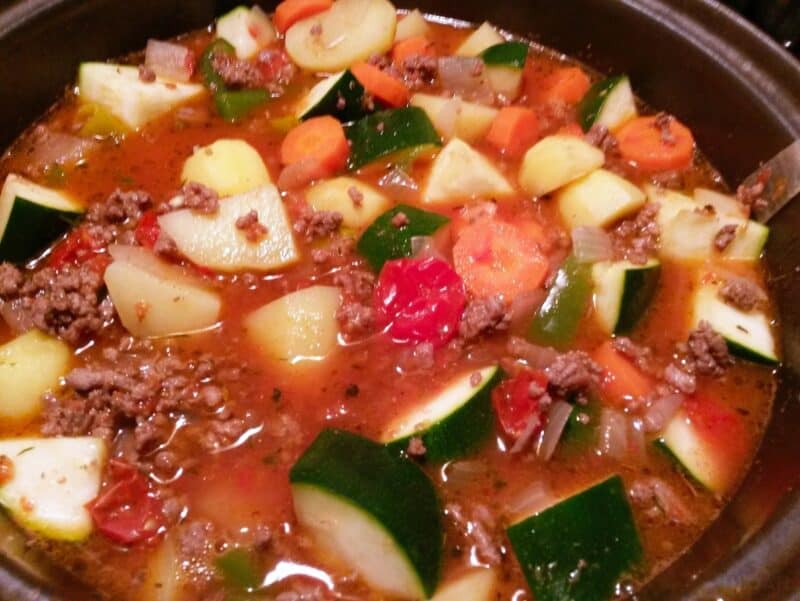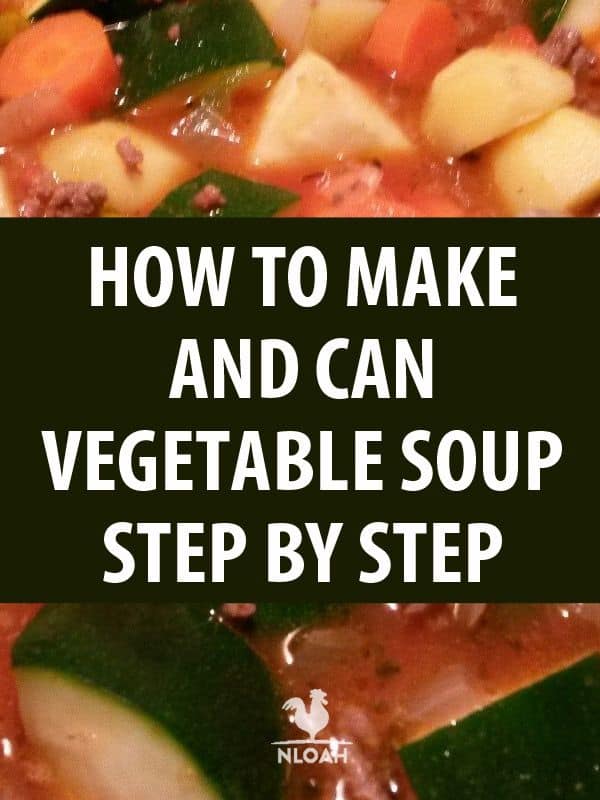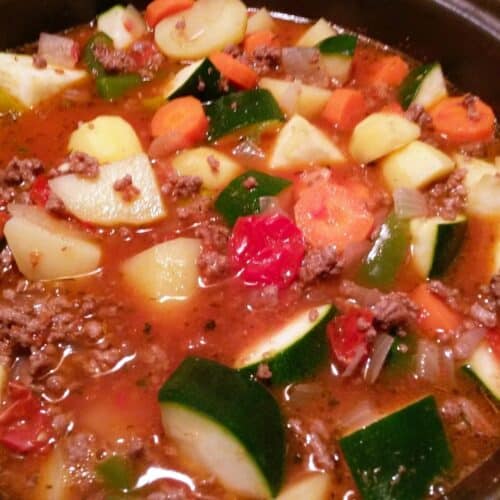With the fall months quickly nipping at my heels, I am beyond ready to start canning up my favorite winter soups. A family favorite is homemade vegetables…
My kids and husband love reaching for a jar off the pantry shelves during the blusteriest parts of winter. Nothing beats a hot bowl of homemade soup when your body is literally chilled to the bone.

Out of all the soups that I make and preserve, I make the largest batch of veggies. Everyone in my household loves it. Plus, it contains all sorts of yummy vitamins and nutrients.
When I was a little girl I can remember my mother doing the exact same thing. We didn’t have much money but we had a ton of kids, so mom was always trying to cut down on the food bill. Growing and making our own food helped her accomplish this.
Each summer, mom would harvest the vegetables from our large garden and begin the process of preservation. She would freeze some of them and can the rest. Many of her veggies ended up in soups and preserved on the pantry shelves.
I grew up in a family of 5 children, so it typically took 3 to 4 quarts of soup to feed all of us plus mom and dad. You can imagine how many jars of soup mom had to can in order to keep a few veggie soup meals on the shelves for us to enjoy throughout the winter months.
Canning vegetable soup is relatively easy, and it allows you to taste the fruits of your summer harvest all year long.
I have used a hot water bath canner when preserving vegetable soup due to the high acid content of the tomatoes and their juice. However, there are some low-acid vegetables in the soup so to be on the safe side, I’m going to give you a pressure canner recipe.
Please know that you are not strictly adhered to the veggies listed below. Feel free to use whichever you enjoy. Many people like to add things such as rutabaga and cabbage. In fact, if you are low-carbing, replacing the potatoes with rutabaga is ideal. They are much like a white potato without all the starch.
You may need to adjust the salt and pepper a bit based on your tastes. Add them in slowly. You can always add more but you can’t take any out.
Without further ado, let’s get cooking!
Does Vegetable Soup Have to Be Pressure Canned?
Keep in mind that you MUST use a pressure canner when canning vegetable soup. This food is low in acid and makes it unsafe to be processed with a hot water bath canner.
Feel free to use quart, pint, or even half-pint jars for your soup. I like to can up a few half-pint jars for single serve sizes. They make a wonderful lunch for my children who homeschool.
Soon, you’ll be enjoying a jar of homemade vegetable soup on a cold day with your family, too!
What Types of Vegetable Soups Can Be Canned?
You can process just about any type of vegetable soup in a pressure canner. If you want to use a water bath canner, unfortunately, tomato soup is really the only safe option since it’s the only kind of vegetable with enough acidity to make water bath canning safe.
Some vegetable soups that can be processed in a pressure canner include:
- Classic chicken soup with vegetables
- Beef stew with vegetables
- Potato soup
- Leek soup
- Carrot soup
- Cabbage soup
- Cucumber soup
- Onion soup
- Minestrone
Avoid canning cream-based soups, like cream of broccoli or cream of mushroom, since the dairy doesn’t hold up well to the high heat of canning.
How Do You Preserve Homemade Soup?
Preserving homemade soup is an easy way to make one large batch of soup and enjoy it for multiple meals throughout the week.
Freezing is the most common way to store your soup, as it removes the temperature from being a factor in spoilage. It is best to invest in airtight, freezer-safe containers that won’t leak or absorb any unpleasant tastes or smells within your freezer. If you are storing large quantities of soup, do not fill the container all the way up; leave some room at the top since liquids tend to expand when frozen.
Make sure to date your containers so that you can keep track of how long they have been stored and discard anything that has been there too long.
Another great preservation method is dehydration, which requires the use of either a dehydrator or an oven set to low heat in order to slowly remove any moisture from the soup.
Dehydration results in crispy, chip-like pieces that can be rehydrated later on with a bit of water or broth–it’s a great way to prolong the flavor of your homemade soup!
Vegetable Soup Canning Instructions
Equipment
- Pressure canner
- Canning jars, rings, and lids
- Jar lifter
- peeler
- Stockpot
- Knives
Ingredients
- 4 quarts tomatoes 24 large tomatoes, peeled, cored, and roughly chopped
- 12 potatoes cubed
- 24 carrots chopped
- 8 cups lima beans
- 8 cups uncooked corn right off the ear is best
- 4 cups celery chopped
- 4 cups onion chopped
- 12 garlic cloves chopped
- 12 cups water
- salt and pepper to taste
Instructions
- First things first, you want to sterilize your jars, lids, and rings in hot boiling water for at least 10 minutes. Leave the jars in the hot water until you are ready to use them.
- After you have prepared all of your vegetables, place them into a large stock pot along with the 12 cups of water and salt and pepper, and boil for 5 minutes.
- Next, ladle the hot soup into the hot jars and leave about 1” of headspace at the top. Remove any air bubbles with a butter knife.
- Place the lids and rings on the jars and screw them on tightly.
- Process the pint-sized jars for 60 minutes and quart-sized jars for 75 minutes at 10 pounds of pressure in a pressure canner.
Notes
- If you live at a higher altitude, processing times and amount of pressure may vary. Please refer to your canner owner’s manual for instructions.
- I leave the peels on my potatoes and carrots for extra nutrition and texture. Feel free to peel your veggies if you prefer.
- The 5-minute boil time for the soup is intentional. Completely boiling the veggies and rendering them soft will result in you having mushy vegetables after you process the soup.
How Long Does Canned Vegetable Soup Last?
Vegetable soup that has been canned at home can last up to 12 months when stored properly in a cool, dry place. In most cases, it will last even longer than that, but the quality might diminish.
The key factor in determining the shelf life of canned goods is temperature. If the temperature is too high, the food will spoil more quickly; if it’s too low, the food won’t be as flavorful or nutritious. Cans should always be kept away from light as this will also cause them to spoil faster.
When storing canned goods of any kind, it’s important to examine them for any signs of spoilage before eating them.
The most obvious sign of spoilage is a bulging or dented can—this indicates that the food inside may have gone bad and should not be eaten. Additionally, if you open a can and the contents look or smell off in any way (e.g., discoloration or odd odors), then it’s best not to risk consuming it and instead discard it safely away from pets and children.
If you want your home-canned vegetable soup to last as long as possible, there are several steps you can take to ensure its safety and longevity:
- Store cans in a cool (50-70°F) and dry place away from direct sunlight.
- Check cans periodically for signs of spoilage (bulging/denting).
- Rotate cans so that older ones are used first (first in/first out rotation).
- Label cans with expiration dates so that they don’t get forgotten about over time.
Vegetable Soup Canning Notes and Recipe Variations
Here are a few common questions I’m asked when canning vegetable soup.
It’s Important to Sterilize Your Jars!
Making sure your jars are completely sterile is a vital step to the canning process. Any little bit of bacteria or fungus can cause your vegetable soup to go bad, even after it has been sealed. You don’t want to open up a jar of soup and find mold growing in it.
Even worse, you don’t want to have the soup grow botulism, something you can’t see, consume it, and become gravely ill.
Can I Use Other Vegetables in This Soup Recipe?
Yes! You’re free to use any other kinds of vegetables in this soup. Since it’s being pressure canned, you shouldn’t have to worry too much about substituting or adding new vegetables – just try to use an approved recipe if you go too far outside of the box.
Some vegetables you may want to add to your home-canned vegetable soup include:
- Green beans
- Broccoli
- Peas
- Zucchini
- Cauliflower
Again, these are not included in this recipe, so just double-check for any timing or pressure variations you might need to make based on an approved recipe.
Can I Add Meat or Bone Broth?
In some cases, many people will ask if they can add meat or bone broth to the recipe while pressure canning it. It’s important to remember that adding any animal protein could present risks of contamination and make the soup potentially unsafe for consumption if you don’t double check your timing and pressure levels.
In most cases, it’s totally fine to add these – but again, make sure you’re using an approved recipe from a resource like the USDA’s National Center for Home Food Preservation or Ball’s Book of Canning.
Adding Pasta Noodles or Rice
When it comes to pressure canning soup, many people add in pasta noodles or rice; however, this isn’t necessarily recommended. Adding these ingredients before you fully process the soup may result in a mushy texture and could potentially affect the processing time necessary for a safe final product.
For this reason, it is better to wait until after canning and reheat your soup with the noodles or rice added. This will offer an optimal texture when consuming your canned soup.
Can I Add Dairy, Cream, or Thickening Agents, Like Flour?
Adding dairy, cream, and flour to home canned vegetable soup is not advised as these thickening agents can cause the pH level of the food to become too low.
Additionally, when exposed to heat for a long period of time like during canning, proteins within the dairy (such as yogurt or cheese) will break down, causing an unpleasant texture.
Instead of adding these elements during canning, it’s best to save them for after. For example, stirring in some cream before serving adds satisfying richness and delicious flavor without compromising quality.
Is It OK To Use Different Herbs?
When you are pressure canning soup, it’s perfectly fine to swap out various herbs and spices. These won’t affect canning safety.
Some popular herbs to consider adding to your own vegetable soup include:
- Rosemary
- Thyme
- Basil
- Sage
What About Dried Beans?
Adding dried beans to home canned vegetables can be an economical, nutritional, and flavorful way to diversify the flavors in your pantry.
Adding these legumes can increase the nutrition of your vegetable soup, while also enhancing their flavor and texture. To properly add beans during the home-canning process, it’s important to use all materials in a safe fashion, making sure everything is up-to-date. It’s crucial not to skip any steps for food safety – such as soaking dried beans for at least 8 hours prior to canning – otherwise you risk potential health hazards.
Again, try to use an approved recipe if you decide to do this.
Final Thoughts
I hope you and your family enjoy this vegetable soup as much as mine do!
Sometimes, when I crack open a jar of veggie soup, I’ll place it in a pot to simmer and brown a pound of hamburger in a skillet. Once the hamburger is cooked, I’ll drain the fat and toss it into the soup for an even heartier meal.

Jessica Faidley is a stay-at-home, work-from-home, homeschooling mom who loves to teach her children how to live off the land.
Herbalism is another topic that Jessica has studied. Keeping herself and her family healthy through a natural approach is her way of doing things.


Can you use dry lima beans? Do you need to cook them first or can you add them fry?
I make Vegetable soup from bought canned vegetables and Hamburg. I keep it hot then put it into my hot jars and lids and put in a water bath for 60 minutes. Would that be safe being the vegetables were already canned?
From all my reading on canning, and I’ve done a lot! You MUST pressure vegetable soup to be safe. Water bath is not sufficient.
I live at 1010 altitude and was wondering… am I safe to use the under 1000
I make a canned chicken soup base product that will keep for years on the shelf, and is a quick and easy way to have a hot, satisfying meal in the dead of winter, or if you are sick and need some quick comfort food.
Cut up the whole chicken into large pieces, put in a pot and cover with water. Simmer until the chicken is cooked through. Remove the chicken and allow to cool, then remove bones and skin, and cut/tear the chicken meat into small pieces. (You can put the bones and skin back into the stock pot and continue to simmer, adding richness to your stock.)
Separately, chop up celery, carrots and onions.
In a clean quart canning jar, in the following order, add one cup of onions, one cup of celery, one cup of carrots and one cup of chicken. Add enough broth to cover the chicken, which should leave about 1″ of head space. Remove air bubbles, wipe jar rims, and put on lids and rings, finger tight.
Process at 10lb (if under 1000′ altitude, 15lb if above 1000′) for 90 minutes, then turn off heat. I leave the jars in the canner until it cools to 0psi and then remove the jars and allow them to cool, draft free, for 24 hours. I then remove the rings, check the seal and wash jars and rings. Allow to dry and with a permanent marker, write the year on the jar lid. Store jars in a cool, dark, dry location.
When ready to use, dump the contents of the soup in a pot, and add a quart of chicken stock, heat and eat.
I’ve opened jars that were almost 8 years old and the soup was just as good tasting as the day it was canned.
Having clean jars, bands and lids is important, but sterilizing prior to use is a waste of time, imo, if you are pressure canning. The entire contents of the jar, and the jar, ring and lid, are heated to 240F during the pressure canning process, a heat level greater than the 212F boiling water used in the sterilization process.